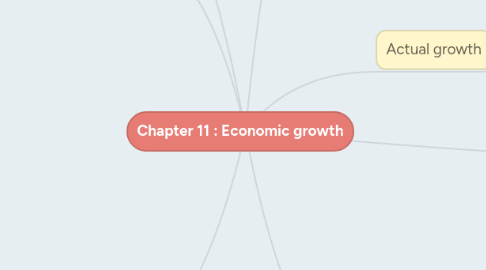
1. Potential growth
1.1. This is the rate at which the economy could grow if it were to use all its resources
1.2. It is a long-run concept to explain determination of potential national income and refers to the expansion of an economy's capacity to produce goods and services over long period of time.
1.3. When there is potential growth, there may also be actual growth.
2. Sources of Potential Growth
2.1. Increase in quantity of labour
2.1.1. The size of labour force affects the level of output of a country. It dependents on two factors: the population size and the labour participation rate.
2.1.1.1. Government can lose immigration policy.
2.1.1.2. Government could implement incentives to encourage a greater proportion of the population to join the labour force, thereby, increasing the labour participation rate
2.1.1.3. However, too rapid population growth can be detrimental to the economic growth of a country if production of goods and services is unable to keep up.
2.2. Increase in quality of labour
2.2.1. The health of the labour force, and their level of knowledge and skills determine the quality of labour.
2.2.1.1. Government can improve the healthcare system, and encourage more people to take up higher education and retraining.
2.3. Increase in quality of capital
2.3.1. Better capital equipment can facilitate growth and be facilitated by an increase in research and development activities
2.4. Increase in quantity of capital
2.4.1. A high rate of capital formation (Investment <=>saving) can be increase through domestic savings, business savings, loans/investments from abroad, aid from developed countries and international agencies.
2.5. Increase in quantity and quality of natural resorces
2.5.1. Including land space, mineral resources, location of land, climatic forces and productive agricultural grounds. This can be achieved through the discovery of new resource deposits or land reclamation.
2.6. Increase in level of entrepreneurship
2.6.1. The more dynamic the entrepreneurs are in the economy, the better the economy. The more innovations and new methods of production there are → greater output and possibility of expanding to new markets.
2.7. Technological progress
2.7.1. Increase in application of new scientific knowledge in the form of inventions and innovatio ns
2.8. Increase in level of entrepreneurship
3. Economic development
3.1. The process of raising the standard of living and well-being of the population of the developing countries. It includes the reduction of poverty in the distribution of income in the context of a developing country
3.1.1. Measurement of economic development 1. Material and non-material aspects of well-being. Real GDP per capita is the most commonly used indicator of economic development.
4. Actual growth
4.1. The percentage annual increase in national output. It is usually calculated in real terms to eliminate the effect of inflation on the price of goods and services produced.
4.2. Formula: (Real GDP in year 2 - Real GDP in year 1)/Real GDP in year 1
4.3. The actual growth rate fluctuates with swings of the business cycle and is affected by changes in aggregate expenditures.
5. Sources of Actual growth
5.1. Actual growth occurs when there is a increase in the real national income. This can be due to a rightwards shift of AD curve or a downward shift of AS curve. (Any factor gives an increase to real national income.
6. Benefits of Economic growth
6.1. More and better Goods and services
6.1.1. Leads to higher real income per capital. → leads to higher levels of consumption of goods and services. If human welfare is related to higher levels of consumption, it will be an obvious gain to society
6.2. More employment oppotunities
6.2.1. Labour is a derived demand, when the demand for goods and services increase, demand for labour increases.
6.3. Alleviation of poverty
6.3.1. Government can redistribute incomes from the rich to the poor without the rich losing.
6.3.1.1. For example : When people's income rise, they automatically pay more taxes. This extra revenue can be used by the government in programmes to alleviate poverty.
6.4. National prestige/ Economic might
6.4.1. People have aspirations of rising living standard of. This is because economic growth brings about ability to consume better and more goods and services.
7. Costs of Economic growth
7.1. Reduced present comsumption
7.1.1. The fiance can come from higher savings or higher taxes. Either way, there must be a cut in consumption. In short, therefore, higher growth leads to less consumption.
7.2. Effects on distribution of income
7.2.1. While some people gain from a higher standard of living, others are likely to lose. If the means to higher growth are greater incentives, then the rich might get richer; with little or benefits "trickling down" to the poor.
7.3. Environmental costs
7.3.1. A richer society may be more concerned for the environment, but it is also likely to do more damage to it. The higher the level of consumption, the higher is likely to be the level of pollution and waste. Many of the environment costs are likely to be underestimated due to a lack of scientific knowledge.
7.4. Social costs
7.4.1. Many people claim that an excessive pursuit of material growth by a country can lead to a greedier, more selfish and less caring society. As society becomes more industrialised, violence,crime, loneliness, stress-related diseases, suicides, divorces and other problems are likely to arise.
